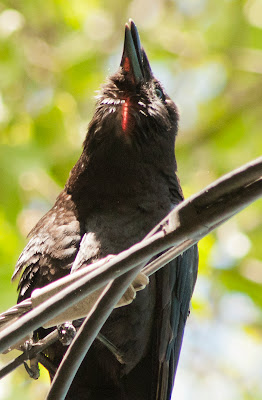A few tell-tale anatomical features of a young crow are well-displayed here: its blue eyes and pinkish-red inner mouth (called a gape by ornithologists). The angle of the sun and the crow's posture coincide to strikingly illuminate its cherry-red mouth.
Many bird species have a gape in the red-orange-pink-yellow range; the generally accepted explanation is that such bright coloration helps the parent bird more readily hit its target when arriving with food for its young. In other words, the brighter the gape, the greater a nestling's competitive advantage over its siblings.
In another pleasing coincidence, right across the street from this cherry-gaped crow were bunches of cherries, also enhanced by the sun.
Sunday, January 29, 2012
Wednesday, January 18, 2012
Crow Alpinist?
Crows are curious and tenacious and will explore an object quite exhaustively (to our eyes, at least). This bird seems more concerned with pecking at the object's rim than in using it to gain unlimited sled rides. Notice how it continues to drill it after ride #2. It then takes the object back to the roof's apex for more beakwork--rather than setting itself up for another downhill ride. Nor do I see the crow making a connection between its pecking motion/body weight propulsion and the ensuing downhill ride.
I will admit to some very non-scientific anthropomorphic outbursts when it comes to our avian friends (see, there I go again!), but in this case, I'm gonna play it more objectively.
Thank you to fellow crow-lover John S. for sharing with me!
Addendum as of January 29: After further conversation with a few others, I should clarify that I don't deny that the crow experienced some enjoyment or sense of "play" from the slide. But I don't believe enjoyment was the bird's primary motivation. Any positive experience of that nature, I posit, was secondary and/or incidental to its primary motivation, which was figuring what out what the hell that lid is and/or does it have any edible food particles.
Subscribe to:
Comments (Atom)

